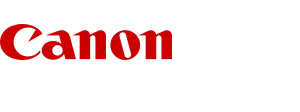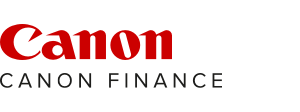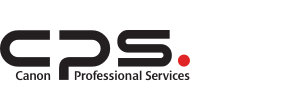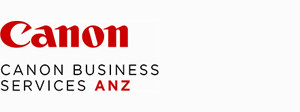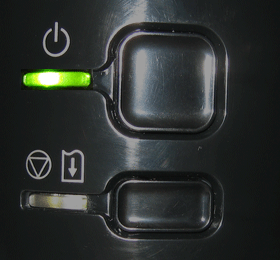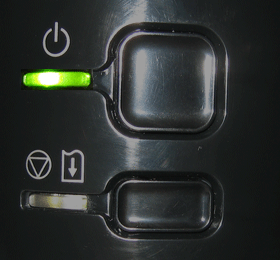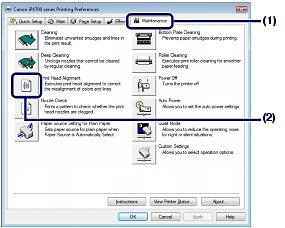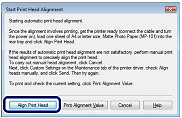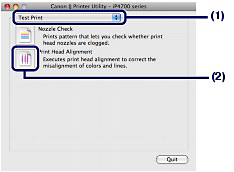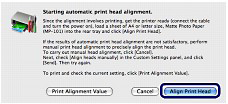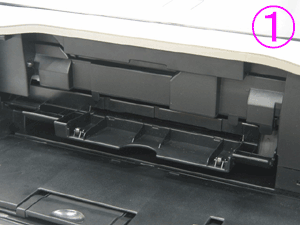Issue
When a printer error occurs, the Alarm lamp flashes orange as shown below. The number of flashes indicates the type of error that has occurred. Count the flashes and take the appropriate action to correct the error.
Caution
Power Lamp Flashes Green and Alarm Lamp Flashes Orange Alternately
A printer problem has occurred.
Disconnect the printer cable from the printer, turn the printer off, and then unplug the printer from the power supply.
Plug the printer back in and turn the printer back on.
If the problem is not resolved, contact your Canon service representative.
Cause and solution
Two flashes:Printer is out of paper/Paper does not feed
Reload paper in the Rear Tray or Cassette and press the RESUME/CANCEL button on the printer.
Cause and solution
Three flashes:Paper Output Tray is closed/Paper jam
If the Paper Output Tray is closed, open it. The printer resumes printing.
If opening the Paper Output Tray does not resolve the problem, or if the tray was open to begin with, the paper may be jammed. Remove the jammed paper, reload paper properly in the printer, then press the RESUME/CANCEL button on the printer.
Cause and solution
Four flashes:Ink tank is not installed properly/Ink may have run out
-⋗ [ Replacing an Ink Tank ]
Caution
Cause and solution
Five flashes:Print Head is not installed/Print Head is defective
Follow the directions given in your setup manual to install the Print Head.
If the Print Head is already installed, remove the Print Head once and then reinstall it.
If the error is still not resolved, the Print Head may be damaged. Contact your Canon service representative.
If printed ruled lines are misaligned or print results are otherwise unsatisfactory, adjust the print head position.
You need to prepare: a sheet of A4 or Letter-sized supplied paper or Canon Matte Photo Paper MP-101
Caution
Replace the ink tank whose ink is low.
See [ Replacing an Ink Tank ]
- Aligning the Print Head without a computer
(1) Make sure that the power is turned on, and load a sheet of A4 or Letter-sized supplied paper or Canon Matte Photo Paper MP-101 in the Rear Tray. Load it with the printing side (whiter side) facing you in the Rear Tray.
(2) Open the Paper Output Tray gently, and extend the Output Tray Extension to open.
If the Inner Cover is open, close it.
(3) Hold down the RESUME/CANCEL button until the Power lamp flashes green four times, then release it immediately.
The print head alignment pattern will be printed and the printer will adjust the print head position automatically.
Do not perform any other operations until the printer completes the printing of the print head alignment pattern.
Automatic Print Head Alignment
1. Make sure that the power is turned on.
2. Load a sheet of A4 or Letter-sized supplied paper or Canon Matte Photo Paper MP-101 in the Rear Tray.
Load it with the printing side (whiter side) facing you in the Rear Tray.
Caution
3. Open the Paper Output Tray gently, and extend the Output Tray Extension to open.
Caution
4. Open the printer driver setup window.
5. Adjust the print head position.
(1) Click the Maintenance tab.
(2) Click Print Head Alignment.
(3) Confirm the displayed message, and click Align Print Head.
The print head alignment pattern will be printed and the printer will adjust the print head position automatically.
Do not perform any other operations until the printer completes the printing of the print head alignment pattern. This takes about 5 minutes to complete.
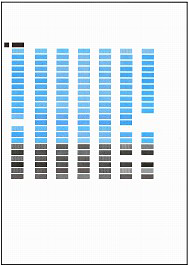
Caution
1. Make sure that the power is turned on.
2. Load a sheet of A4 or Letter-sized supplied paper or Canon Matte Photo Paper MP-101 in the Rear Tray.
Load it with the printing side (whiter side) facing you in the Rear Tray.
Caution
3. Open the Paper Output Tray gently, and extend the Output Tray Extension to open.
Caution
4. Open the Canon IJ Printer Utility.
5. Adjust the print head position.
(1) Select Test Print in the pop-up menu.
(2) Click Print Head Alignment.
(3) Confirm the displayed message, and click Align Print Head.
The print head alignment pattern will be printed and the printer will adjust the print head position automatically.
Do not perform any other operations until the printer completes the printing of the print head alignment pattern. This takes about 5 minutes to complete.

Caution
Manual Print Head Alignment
This section describes how to align the Print Head manually.
If the results of Automatic Print Head Alignment are not satisfactory, follow the procedure below to perform Manual Print Head Alignment to precisely align the Print Head.
Caution
1. Make sure that the printer is turned on.
2. Load three sheets of A4 or Letter-sized plain paper in the Cassette.
3. Open the Paper Output Tray and extend the Output Tray Extension.
4. Print the pattern.
(1) Open the printer properties dialog box.
(2) Click the Maintenance tab, then Custom Settings.
(3) Select the Align heads manually check box, then click Send.
(4) Confirm the displayed message and click OK.
(5) In the Maintenance sheet click Print Head Alignment.
(6) Confirm the displayed message and click Align Print Head.
Caution
Caution
(7) After the pattern is printed, click Yes.
The dialog for entering a print head alignment value is displayed.
5. Look at the first printout and adjust the print head position.
(1) Check the printed patterns and select the number of the pattern in column A that has the least noticeable vertical streaks.
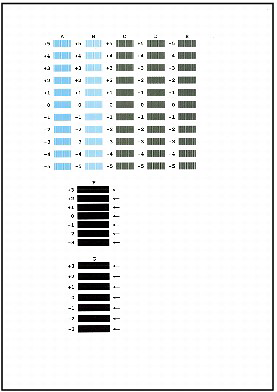
Caution
(A) Less noticeable vertical white streaks
(B) More noticeable vertical white streaks
2. Repeat the procedure until you finish inputting the pattern number for column G, then click OK.
For column F and G, pick the setting that produces the least noticeable horizontal streaks.
Caution
(C) Less noticeable horizontal white streaks
(D) More noticeable horizontal white streaks
3. Confirm the displayed message and click OK.
The second pattern is printed.
Caution
6. Look at the second printout and adjust the print head position.
(1) Check the printed patterns and select the number of the pattern in column H that has the least noticeable vertical streaks.
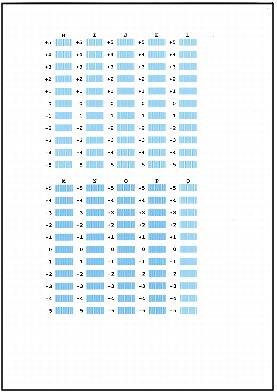
Caution
(E) Less noticeable vertical white streaks
(F) More noticeable vertical white streaks
(2) Repeat the procedure until you finish inputting the pattern number for column Q, then click OK.
(3) Confirm the displayed message and click OK.
The third pattern is printed.
Caution
7. Look at the third printout and adjust the print head position.
(1) Check the printed patterns and select the number of the pattern in column a that has the least noticeable horizontal streaks.
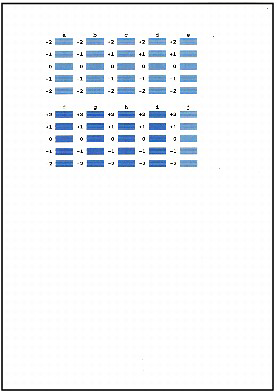
Caution
(G) Less noticeable horizontal white streaks
(H) More noticeable horizontal white streaks
(2) Repeat the procedure until you finish inputting the pattern number for column j, then click OK.
(3) Confirm the displayed message and click OK.
1. Make sure that the printer is turned on.
2. Load three sheets of A4 or Letter-sized plain paper in the Cassette.
3. Open the Paper Output Tray and extend the Output Tray Extension.
4. Print the pattern.
(1) Open the Canon IJ Printer Utility dialog box.
(2) Select Custom Settings in the pop-up menu.
(3) Select the Align heads manually check box, then click Send.
(4) Confirm the displayed message and click OK.
(5) Select Test Print in the pop-up menu.
(6) Click Print Head Alignment.
(7) Confirm the displayed message and click Align Print Head.
The dialog for entering a print head alignment value is displayed.
Caution
Caution
5. Look at the first printout and adjust the print head position.
(1) Check the printed patterns and select the number of the pattern in column A that has the least noticeable vertical streaks.

Caution
(A) Less noticeable vertical white streaks
(B) More noticeable vertical white streaks
2. Repeat the procedure until you finish inputting the pattern number for column G, then click Send.
For column F and G, pick the setting that produces the least noticeable horizontal streaks.
Caution
(C) Less noticeable horizontal white streaks
(D) More noticeable horizontal white streaks
(3) Confirm the displayed message and click OK.
The second pattern is printed.
Caution
6. Look at the second printout and adjust the print head position.
(1) Check the printed patterns and select the number of the pattern in column H that has the least noticeable vertical streaks.

Caution
(E) Less noticeable vertical white streaks
(F) More noticeable vertical white streaks
(2) Repeat the procedure until you finish inputting the pattern number for column Q, then click Send.
(3) Confirm the displayed message and click OK.
The third pattern is printed.
Caution
7. Look at the third printout and adjust the print head position.
(1) Check the printed patterns and select the number of the pattern in column a that has the least noticeable horizontal streaks.

Caution
(G) Less noticeable horizontal white streaks
(H) More noticeable horizontal white streaks
(2) Repeat the procedure until you finish inputting the pattern number for column j, then click Send.
Cause and solution
Six flashes:The Inner Cover is opened
If the Inner Cover is open when starting printing on paper, close the Inner Cover, then press the RESUME/CANCEL button on the printer.
Cause and solution
Seven Flashes:Ink tank is not installed in the correct position
Confirm that the ink tanks are installed in the appropriate positions.
When ink runs out while printing is in progress, the Alarm lamp will flash orange four times and the error message will appear on your computer screen. Make sure which ink tank has run out of ink and replace it with a new one.
Caution
When the ink tanks run out of ink, follow the procedure below to replace them.
Caution
Caution
1. Make sure that the power is turned on, and open the Paper Output Tray gently.
2. Open the Top Cover.
The Print Head Holder moves to the replacement position.
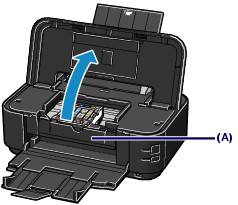
Caution
Caution
Caution
3. Remove the ink tank with the lamp flashing fast.
Push the tab (B) and lift the ink tank to remove.
Do no touch the Print Head Lock Lever (C).
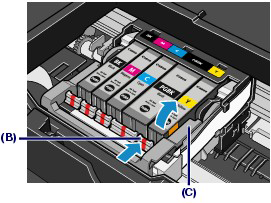
Caution
Caution
4. Prepare the new ink tank.
(1) Take a new ink tank out of its package, pull the orange tape (1) in the direction of the arrow to peel it off, then remove the film (2).
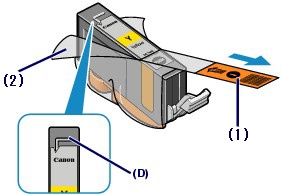
Caution
(2) Hold the orange protective cap (E) as indicated in the figure below, then twist and remove it from the bottom of the ink tank.
Remove the protective cap while holding it to prevent the ink from staining your fingers.
Discard the protective cap once it is removed.
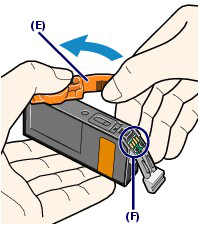
Caution
Caution
5. Install the new ink tank.
(1) Insert the front end of ink tank into the Print Head at a slant.
Make sure that the position of the ink tank matches the label.
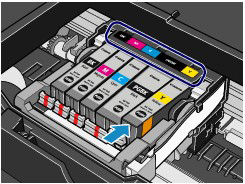
(2) Press the mark 
Make sure that the ink lamp lights up red.
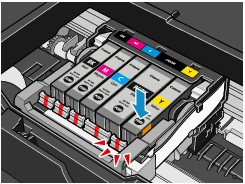
Caution
6. Close the Top Cover.
Caution
Cause and solution
Eight flashes:Ink absorber is almost full
The ink absorber is becoming full.
The printer has a built-in ink absorber to hold the ink used during Print Head Cleaning.
Press the RESUME/CANCEL button on the printer to cancel the error so you can continue printing. Before the ink absorber becomes completely full, contact a Canon service representative. (You will need to replace a particular part of the printer.)
Cause and solution
Nine flashes:The printer has not received a response from the digital camera. The digital camera or digital video camcorder connected is not compatible with this printer
Cause and solution
Ten flashes:Cannot perform duplex printing
The size of paper may not be compatible with automatic duplex printing. The sizes of media suitable for auto duplex printing are A4, Letter, A5, and 5" x 7". Make sure that the size of the paper loaded in the printer is correct. Pressing the RESUME/CANCEL button will eject the paper and restart printing from the front side of the next paper. The reverse side of the ejected sheet will not be printed.
Cause and solution
Eleven flashes:Automatic Print Head Alignment failed
-⋗ [ Printing the Nozzle Check Pattern ]
Press the RESUME/CANCEL button to dismiss the error, and then adjust your operating environment and/or the position of the printer so that the Paper Output Slot is not exposed directly to strong light.
After carrying out the above measures, if the problem continues after aligning the Print Head again, press the RESUME/CANCEL button to dismiss the error, and then perform Manual Print Head Alignment.
If printed ruled lines are misaligned or print results are otherwise unsatisfactory, adjust the print head position.
You need to prepare: a sheet of A4 or Letter-sized supplied paper or Canon Matte Photo Paper MP-101
Caution
Replace the ink tank whose ink is low.
See [ Replacing an Ink Tank ]
- Aligning the Print Head without a computer
(1) Make sure that the power is turned on, and load a sheet of A4 or Letter-sized supplied paper or Canon Matte Photo Paper MP-101 in the Rear Tray. Load it with the printing side (whiter side) facing you in the Rear Tray.
(2) Open the Paper Output Tray gently, and extend the Output Tray Extension to open.
If the Inner Cover is open, close it.
(3) Hold down the RESUME/CANCEL button until the Power lamp flashes green four times, then release it immediately.
The print head alignment pattern will be printed and the printer will adjust the print head position automatically.
Do not perform any other operations until the printer completes the printing of the print head alignment pattern.
Automatic Print Head Alignment
1. Make sure that the power is turned on.
2. Load a sheet of A4 or Letter-sized supplied paper or Canon Matte Photo Paper MP-101 in the Rear Tray.
Load it with the printing side (whiter side) facing you in the Rear Tray.
Caution
3. Open the Paper Output Tray gently, and extend the Output Tray Extension to open.
Caution
4. Open the printer driver setup window.
5. Adjust the print head position.
(1) Click the Maintenance tab.
(2) Click Print Head Alignment.
(3) Confirm the displayed message, and click Align Print Head.
The print head alignment pattern will be printed and the printer will adjust the print head position automatically.
Do not perform any other operations until the printer completes the printing of the print head alignment pattern. This takes about 5 minutes to complete.

Caution
1. Make sure that the power is turned on.
2. Load a sheet of A4 or Letter-sized supplied paper or Canon Matte Photo Paper MP-101 in the Rear Tray.
Load it with the printing side (whiter side) facing you in the Rear Tray.
Caution
3. Open the Paper Output Tray gently, and extend the Output Tray Extension to open.
Caution
4. Open the Canon IJ Printer Utility.
5. Adjust the print head position.
(1) Select Test Print in the pop-up menu.
(2) Click Print Head Alignment.
(3) Confirm the displayed message, and click Align Print Head.
The print head alignment pattern will be printed and the printer will adjust the print head position automatically.
Do not perform any other operations until the printer completes the printing of the print head alignment pattern. This takes about 5 minutes to complete.

Caution
Manual Print Head Alignment
This section describes how to align the Print Head manually.
If the results of Automatic Print Head Alignment are not satisfactory, follow the procedure below to perform Manual Print Head Alignment to precisely align the Print Head.
Caution
1. Make sure that the printer is turned on.
2. Load three sheets of A4 or Letter-sized plain paper in the Cassette.
3. Open the Paper Output Tray and extend the Output Tray Extension.
4. Print the pattern.
(1) Open the printer properties dialog box.
(2) Click the Maintenance tab, then Custom Settings.
(3) Select the Align heads manually check box, then click Send.
(4) Confirm the displayed message and click OK.
(5) In the Maintenance sheet click Print Head Alignment.
(6) Confirm the displayed message and click Align Print Head.
Caution
Caution
(7) After the pattern is printed, click Yes.
The dialog for entering a print head alignment value is displayed.
5. Look at the first printout and adjust the print head position.
(1) Check the printed patterns and select the number of the pattern in column A that has the least noticeable vertical streaks.

Caution
(A) Less noticeable vertical white streaks
(B) More noticeable vertical white streaks
2. Repeat the procedure until you finish inputting the pattern number for column G, then click OK.
For column F and G, pick the setting that produces the least noticeable horizontal streaks.
Caution
(C) Less noticeable horizontal white streaks
(D) More noticeable horizontal white streaks
3. Confirm the displayed message and click OK.
The second pattern is printed.
Caution
6. Look at the second printout and adjust the print head position.
(1) Check the printed patterns and select the number of the pattern in column H that has the least noticeable vertical streaks.

Caution
(E) Less noticeable vertical white streaks
(F) More noticeable vertical white streaks
(2) Repeat the procedure until you finish inputting the pattern number for column Q, then click OK.
(3) Confirm the displayed message and click OK.
The third pattern is printed.
Caution
7. Look at the third printout and adjust the print head position.
(1) Check the printed patterns and select the number of the pattern in column a that has the least noticeable horizontal streaks.

Caution
(G) Less noticeable horizontal white streaks
(H) More noticeable horizontal white streaks
(2) Repeat the procedure until you finish inputting the pattern number for column j, then click OK.
(3) Confirm the displayed message and click OK.
1. Make sure that the printer is turned on.
2. Load three sheets of A4 or Letter-sized plain paper in the Cassette.
3. Open the Paper Output Tray and extend the Output Tray Extension.
4. Print the pattern.
(1) Open the Canon IJ Printer Utility dialog box.
(2) Select Custom Settings in the pop-up menu.
(3) Select the Align heads manually check box, then click Send.
(4) Confirm the displayed message and click OK.
(5) Select Test Print in the pop-up menu.
(6) Click Print Head Alignment.
(7) Confirm the displayed message and click Align Print Head.
The dialog for entering a print head alignment value is displayed.
Caution
Caution
5. Look at the first printout and adjust the print head position.
(1) Check the printed patterns and select the number of the pattern in column A that has the least noticeable vertical streaks.

Caution
(A) Less noticeable vertical white streaks
(B) More noticeable vertical white streaks
2. Repeat the procedure until you finish inputting the pattern number for column G, then click Send.
For column F and G, pick the setting that produces the least noticeable horizontal streaks.
Caution
(C) Less noticeable horizontal white streaks
(D) More noticeable horizontal white streaks
(3) Confirm the displayed message and click OK.
The second pattern is printed.
Caution
6. Look at the second printout and adjust the print head position.
(1) Check the printed patterns and select the number of the pattern in column H that has the least noticeable vertical streaks.

Caution
(E) Less noticeable vertical white streaks
(F) More noticeable vertical white streaks
(2) Repeat the procedure until you finish inputting the pattern number for column Q, then click Send.
(3) Confirm the displayed message and click OK.
The third pattern is printed.
Caution
7. Look at the third printout and adjust the print head position.
(1) Check the printed patterns and select the number of the pattern in column a that has the least noticeable horizontal streaks.

Caution
(G) Less noticeable horizontal white streaks
(H) More noticeable horizontal white streaks
(2) Repeat the procedure until you finish inputting the pattern number for column j, then click Send.
Cause and solution
Thirteen flashes:Ink level cannot be detected
The remaining ink level cannot be correctly detected. (The lamp on the ink tank flashes.)
Replace the ink tank and close the Top Cover.
-⋗ [ Replacing an Ink Tank ]
Printing with an ink tank that was once empty may damage the printer.
If you want to continue printing in this condition, you need to release the function for detecting the remaining ink level. Press and hold the printer's RESUME/CANCEL button for at least 5 seconds, and then release it.
With this operation, releasing the function for detecting the remaining ink level is memorized. Please be advised that Canon shall not be liable for any printer malfunction or damage caused by refilled ink tanks.
Caution
-⋗ [ Checking the Ink Status ]
Cause and solution
Fourteen Flashes:Ink tank cannot be recognized
The ink tank is not compatible with this printer. (The lamp on the ink tank is off.)
Install an appropriate ink tank.
When ink runs out while printing is in progress, the Alarm lamp will flash orange four times and the error message will appear on your computer screen. Make sure which ink tank has run out of ink and replace it with a new one.
Caution
When the ink tanks run out of ink, follow the procedure below to replace them.
Caution
Caution
1. Make sure that the power is turned on, and open the Paper Output Tray gently.
2. Open the Top Cover.
The Print Head Holder moves to the replacement position.

Caution
Caution
Caution
3. Remove the ink tank with the lamp flashing fast.
Push the tab (B) and lift the ink tank to remove.
Do no touch the Print Head Lock Lever (C).

Caution
Caution
4. Prepare the new ink tank.
(1) Take a new ink tank out of its package, pull the orange tape (1) in the direction of the arrow to peel it off, then remove the film (2).

Caution
(2) Hold the orange protective cap (E) as indicated in the figure below, then twist and remove it from the bottom of the ink tank.
Remove the protective cap while holding it to prevent the ink from staining your fingers.
Discard the protective cap once it is removed.

Caution
Caution
5. Install the new ink tank.
(1) Insert the front end of ink tank into the Print Head at a slant.
Make sure that the position of the ink tank matches the label.

(2) Press the mark 
Make sure that the ink lamp lights up red.

Caution
6. Close the Top Cover.
Caution
Cause and solution
Fifteen Flashes:Ink tank cannot be recognized
An Ink tank error has occurred. (The lamp on the ink tank is off.)
Replace the ink tank.
When ink runs out while printing is in progress, the Alarm lamp will flash orange four times and the error message will appear on your computer screen. Make sure which ink tank has run out of ink and replace it with a new one.
Caution
When the ink tanks run out of ink, follow the procedure below to replace them.
Caution
Caution
1. Make sure that the power is turned on, and open the Paper Output Tray gently.
2. Open the Top Cover.
The Print Head Holder moves to the replacement position.

Caution
Caution
Caution
3. Remove the ink tank with the lamp flashing fast.
Push the tab (B) and lift the ink tank to remove.
Do no touch the Print Head Lock Lever (C).

Caution
Caution
4. Prepare the new ink tank.
(1) Take a new ink tank out of its package, pull the orange tape (1) in the direction of the arrow to peel it off, then remove the film (2).

Caution
(2) Hold the orange protective cap (E) as indicated in the figure below, then twist and remove it from the bottom of the ink tank.
Remove the protective cap while holding it to prevent the ink from staining your fingers.
Discard the protective cap once it is removed.

Caution
Caution
5. Install the new ink tank.
(1) Insert the front end of ink tank into the Print Head at a slant.
Make sure that the position of the ink tank matches the label.

(2) Press the mark 
Make sure that the ink lamp lights up red.

Caution
6. Close the Top Cover.
Caution
Cause and solution
Sixteen Flashes:Ink has run out
Ink has run out. (The lamp on the ink tank flashes.)
Replace the ink tank and close the Top Cover.
-⋗ [ Replacing an Ink Tank ]
Printing under the current condition may damage the printer.
If you want to continue printing in this condition, you need to release the function for detecting the remaining ink level. Press and hold the printer's RESUME/CANCEL button for at least 5 seconds, and then release it.
With this operation, releasing the function for detecting the remaining ink level is memorized. Please be advised that Canon shall not be liable for any malfunction or trouble which may be caused by continuation of printing under the ink out condition.
Caution
-⋗ [ Checking the Ink Status ]
Cause and solution
Nineteen Flashes:An unsupported USB hub is connected
If a PictBridge compliant device is connected via a USB hub, remove the hub and connect it directly to the printer.

